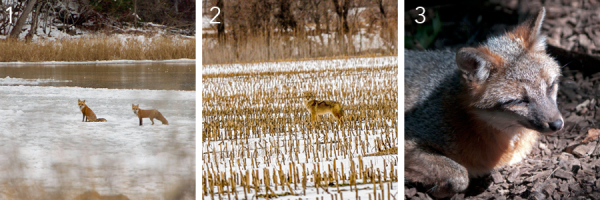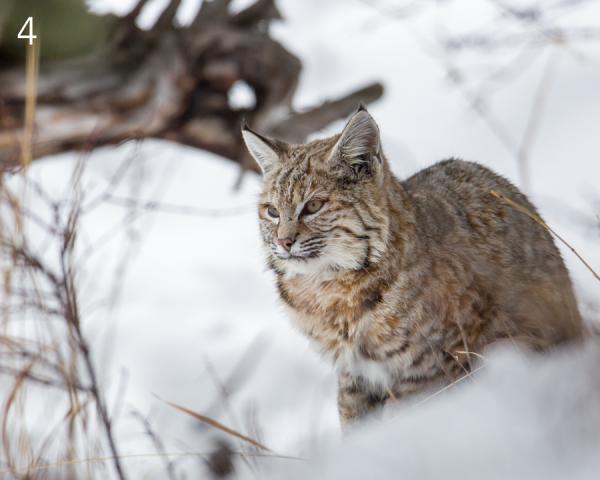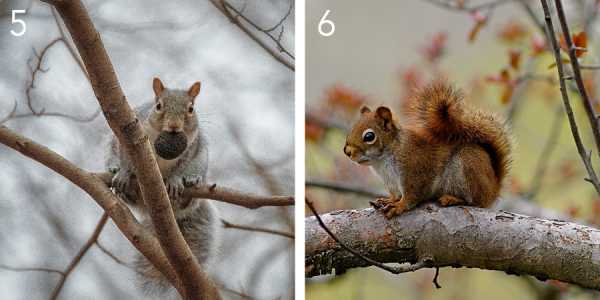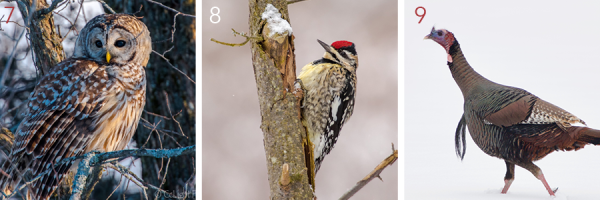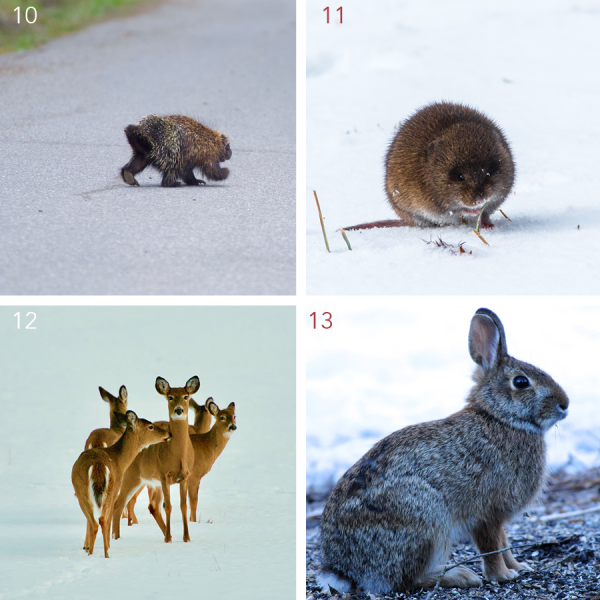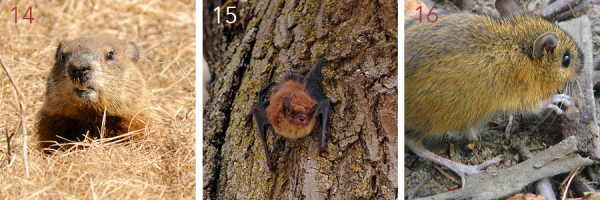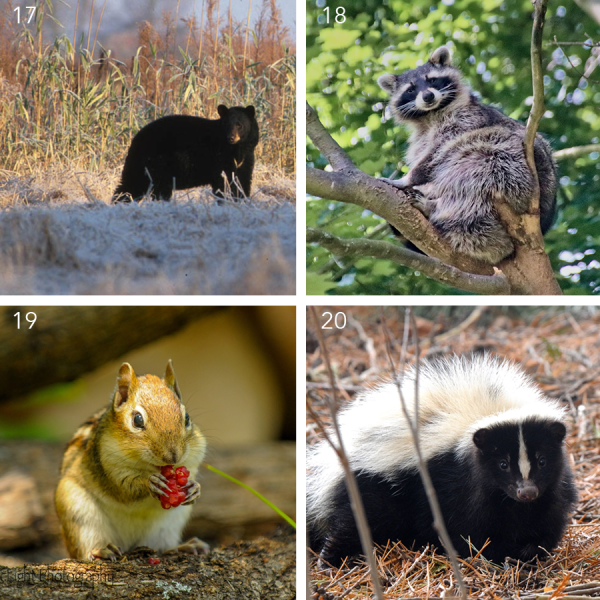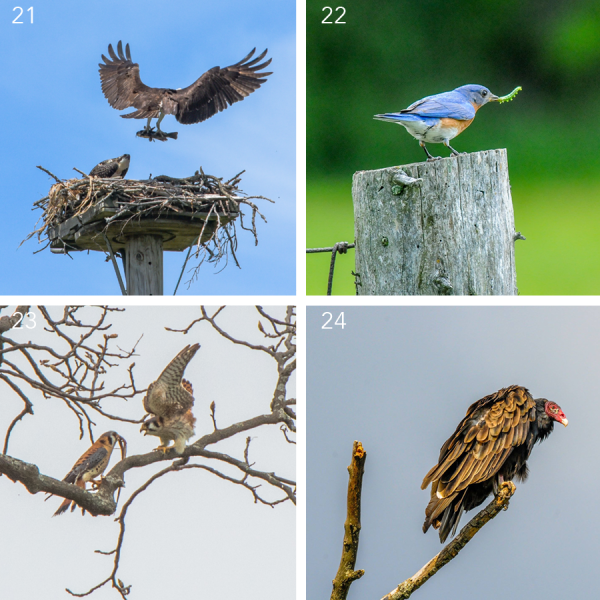Winter Wildlife Detectives: Who’s Out There?
This is the first part of our Winter Wildlife Detective series on our For You & Your Family blog. For further reading, check out
In order to become a winter wildlife detective, it’s important to know who’s out there and who isn’t. Who thrives in the cold Vermont winter? Who takes a long winter nap? Who says, “My bags are packed and I’m out of here!”? And who waits for only the warmest winter days to peek their head out?
When winter comes around, I wear the puffiest, warmest winter coat I have. I turn on the heat in my car and home. I drink yummy hot chocolate. I build fires in the fireplace! How do you adjust to winter? Do you do anything differently than you would in the summer? What winter activities do you enjoy?
Just like you and me, animals adjust and adapt to the cold Vermont winter in many different ways, which we are going to explore in this blog!
Introducing… an all star cast of local Vermont wildlife!
A special thank you to Craig Newman of Outreach for Earth Stewardship for the use of so many of his beautiful photographs!
Survivors and Thrivers: Those That Remain Active in Winter
Some animals are built to take on cold temperatures and snowy conditions. They have special skills, body parts, and behaviors (these are called adaptations) that help them survive and thrive in winter. These adaptations help them stay warm, stay safe from predators, and find food and shelter. When you are out on a winter walk, you can often find clues that these animals left behind while they were outside hunting or gathering food. Let’s learn who some of these animals are a little about their winter survival adaptations!
Some animals that are active in the winter include canids. Canids are doglike animals in the family Canidae. In this family are canines which include dogs and coyotes and vulpines which refers to foxes. Growing warm, thick fur coats is one way these wild animals adapt to winter living.
1. Red fox (Craig Newman) | 2. Coyote (Craig Newman) | 3. Gray fox (Cincinnati Zoo)
Felines, animals in the cat family, also remain active. Have you ever seen a bobcat in the wild? Maybe not because their fur coats help them camouflage into the forest background. Some grow a gray coat that camouflages them even better among the empty winter branches as they hunt for small mammals, which are active in the winter as well.
4. Bobcat (Yellowstone National Park)
We can’t forget about squirrels! You’ve probably learned that squirrels gather and store nuts and seeds for the long winter. Gray squirrels hide tiny caches of nuts and seeds in lots of different hiding spots. Red squirrels hide most of their nuts in one big hiding spot. Whose method would you choose when it comes to hiding food, gray squirrels or red squirrels? Consider the pros and cons of each method.
5. Gray squirrel (Robert Thiemann) | 6. Red Squirrel (Craig Newman)
In Vermont, we have many birds that tough out the wintertime. Some of my favorites are barred owls, turkeys, and woodpeckers. Barred owls have super cool winter adaptations. They have feathers down their legs and allll the way down to their talons. Their hearing is so incredible that they can hear mice traveling under the snow and know exactly where to swoop down and catch them.
7. Barred owl | 8. Woodpecker | 9. Turkey (all Craig Newman)
Some other examples of animals that are active in the winter time are rabbits, deer, moose, voles, and porcupines. Can you think of some adaptations that help these animals survive the cold?
10. Porcupine | 11. Vole | 12. Deer | 13. Rabbit (all Craig Newman)
True Hibernators
Vermont has three types of true hibernators: bats, jumping mice, and groundhogs.
You will not see a true hibernator or any evidence of it in winter. They find a cozy spot and their breathing and heart rate slow wayyyy down. Their body temperatures lower significantly for an extended period of time to conserve energy . For example, the body temperature of a groundhog drops from 99°F (just a little warmer than the human body temp of 98.6°F) all the way down to as low as 37°F (that’s nearly ice cold!). If you came upon a true hibernator, you may think the animal had frozen!
14. Ground Hog (Craig Newman) | 15. Little Brown bat (J. Jongsma) | 16. Jumping Mouse (D.G.E. Robertson)
Sleepers: Snackers and Nappers
These animals have got a solid winter plan that is similar to the true hibernators. They minimize their activity, their hearts beat slower, and they breathe less. But, their temperature doesn’t drop as dramatically. This makes it easier for these animals to wake up and leave their homes to find food on warmer winter days. On colder days, they stay in their homes, become inactive, and are able to live off of the fat stores they have built in fall. On a warm, sunny winter day, you are more likely to find the tracks of (or even see) these animals.
17. Black Bear (Vermont Fish & Wildlife) | 18. Raccoon (dusan veverkolog) | 19. Chipmuck (Craig Newman) | 10. Skunk (crAig Newman)
Migrators
Some birds decide to leave their summer home entirely for more southern locations. Why would they do this? Let’s think about it! Did you know that there are a lot of birds that eat insects? Bats aren’t the only ones who love delicious, juicy bugs! But in the winter, there aren't any insects out and about. I can go outside without getting bitten by mosquitos and I don’t see any insects crawling along the frozen ground. If these bug-eating birds can’t adapt to eat other types of food, then they must fly south to warmer temperatures where bugs are still plentiful.
Does anyone wonder why a turkey vulture would migrate when they are typically eating carrion, the decaying flesh of animal carcasses? Well, turkey vultures rely heavily on their incredible sense of smell, but frozen carrion loses its strong odor. Also, vultures rely on thermal currents (air rising from the sun heated ground) to help them soar effortlessly through the air, but during this cold and cloudy time of year the thermal currents are almost nonexistent.
What if your favorite food is a delicious fish but your pond or lake has totally frozen over? Try flying a little further south until you find open water and can continue to fish!
21. Osprey with a fish | 22. Bluebird with insect | 23. Kestrel with a snake | 24. Vulture (All Craig Newman)
Vermont is FULL of wildlife, and we only mentioned a few animals! Do you have a favorite Vermont animal that we didn’t list? See if you can figure out what it does in the wintertime and what special adaptations it may have for surviving and thriving.
Resources
- Coping with Cold from Shelburne Farms' Project Seasons
- New England Animals in Winter from Shelburne Farms' Project Seasons
- A Winter's Meal from Shelburne Farms' Cultivating Joy & Wonder
- Winter Animals Cards from Shelburne Farms' Cultivating Joy & Wonder
- Forever Wild - a story of the A Shared Life: People and Biodiversity in Vermont collection (for older students, adults)
Books about animals in winter
- Over and Under the Snow by Kate Messner, art by Christopher Silas Neal
- Mousekin’s Woodland Sleepers by Edna Miller (out of print, but you may be able to find used or in the library)
- When Winter Comes by Nancy Van Laan, art by Susan Gaber
- Animals in Winter by Henrietta Bancroft and Richard G. Van Gelder, art by Helen K Davie
- Snow Rabbit, Spring Rabbit: A Book of Changing Seasons by Il Sung Na

